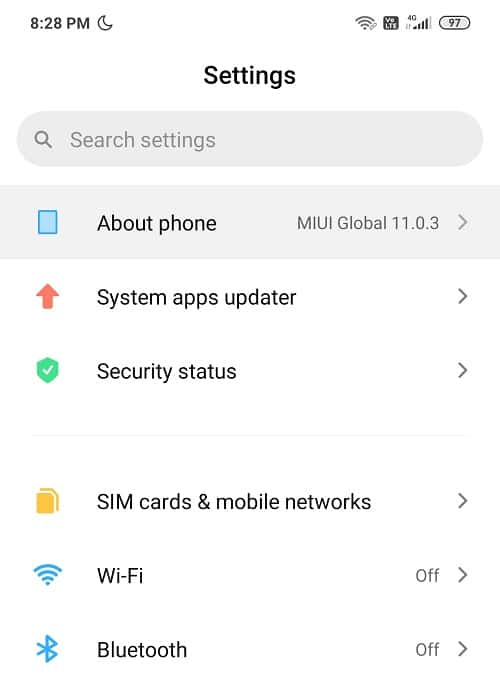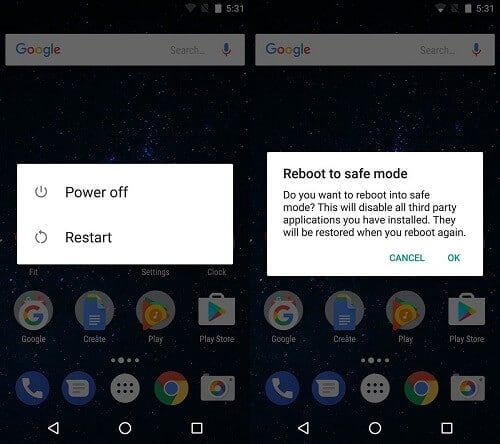But, what happens when the life-saving power button comes out to be faulty? How will you reboot the device then? Well, guess what? That’s what we are here for, to solve all your issues!
How to Restart or Reboot Your Android Phone?
We have listed down a number of ways to restart your Android Device. So, what are we waiting for? Let’s get started!
How to Restart or Reboot Your Android Phone? #1 Perform a Standard Restart #2 Switch it Off then Turn it back ON #3 Try Hard Restarting or Hard Reboot #4 Remove Your Phone’s Battery #5 Use ADB to Reboot from your PC #6 Factory Reset Your Device #7 Reboot Your Device to Save Mode #8 Close the Apps running in Background
#1 Perform a Standard Restart
Our first and foremost suggestion would be to restart the phone with built-in software options. It is worth giving the default method a chance. The steps to Reboot/ Restart your phone would be as follows:
Press and hold the Power button (usually found on the top right side of the mobile). In some cases, you have to select the Volume Down + Home button until the menu pops up. There is no need to unlock your device to do this process.
Now, select the Restart/ Reboot option from the list and wait for your phone to restart. If this does not work out for you, check out the other methods listed here to Restart or Reboot Your Android Phone.
#2 Switch it Off then Turn it back ON
Another basic yet practical way to reboot your device is to switch off the phone then turn it back on. This method is not only doable but time-efficient as well. All in all, it is the best alternative if your device is not responding to the default method of Rebooting. Steps to do so:
Press and hold the Power button on the left side of the phone. Or, use the Volume Down key plus Home button. Wait for the menu to pop up.
Now tap on the Power Off option and wait for the phone to switch off.
Once this is one, hold the Power button for long until the display flashes. Wait for your device to turn back on. And now you are good to go!
#3 Try Hard Restarting or Hard Reboot
If your device isn’t responding to the Soft Boot method, try taking a chance with the Hard Reboot Method. But hey, don’t stress! This does not work like the Factory Reset option. Your data is still safe and sound. You can use this option when your phone starts to act funny. This is just a more fancy way to Power Off your device and then turns it back on again. It is similar to holding the power button down on our PCs. Steps to do so are:
- Long press the Power button for about 10 to 15 seconds.
- This process will Force Restart your device manually. And that’s all, enjoy!
#4 Remove Your Phone’s Battery
Nowadays, all the Smartphone manufacturers produce integrated phones with non-removable batteries. This reduces the overall hardware of the phone, making your device sleek and shiny. Apparently, that is what the hype is all about at present. But, for the ones who still use a phone with removable batteries, consider yourself lucky. If your phone does not respond to the manual way of Rebooting, try pulling out your battery. Steps to remove your battery are:
Simply, remove the backside of your phone’s body (cover).
Find the little space where you can fit in a lean spatula or a nail to part the two segments. Keep in mind that each phone has a different hardware design.
Be cautious while using thin tools because you don’t want to puncture or damage the insides of your phone. Handle the battery with care as it is very fragile.
After removing the phone’s battery, slide it back in. Now, long-press the Power Button again till your screen flashes. Wait for your phone to turn back on. Voila! Your Android Phone was successfully restarted.
#5 Use ADB to Reboot from your PC
Android Debug Bridge (ADB) is a tool that can help you Reboot your phone with the help of a PC if it does not work out the manual way. This is a feature provided by Google which allows you to communicate with your device and do numerous remote operations such as debugging and installing apps, transferring files, and even rebooting your phone or tablets. Steps to use ADB are:
First, install ADB Tool and Android drivers using the Android SDK (Software Development Kit).
Then, on your Android Device, go to Settings and tap on Additional Settings.
Find the Developer option and tap it.
Under the Debugging section, toggle On the USB Debugging option.
Now, connect your Android Phone to the PC using a USB cable and open the Command Prompt or Terminal.
Simply type ‘ADB devices’ to certain that your device is detected.
If it does not respond, re-check whether the drivers are installed properly or not, if not, re-install them.
Finally, if the command prompt responds saying, ‘list of devices attached’ then type ‘ADB reboot’.
Your Android Phone should now restart smoothly.
#6 Factory Reset Your Device
You should consider resetting your device to factory settings as your last resort. This will make your device as good as new but all your data will be deleted. Not only will it reboot your device but it will also deal with other performance-related issues, such as crashing or freezing of the Apps, lousy speed, etc. Remember, the only problem is that it will delete the entire data from your Android Device. We recommend you to backup the consolidated data and transfer it to either Google Drive or any other external storage. Just follow these steps to factory reset your device:
To factory reset your phone, first save all your data in Google Drive or an external SD Card.
Go to Settings and then tap on About Phone.
Now select Backup and reset option, and then click on Erase All Data under the personal data section.
Simply select the Reset Phone option. Follow the instructions displayed on the screen to Erase everything.
Finally, you will be able to restart the device in a manual way.
Lastly, Restore your data from Google Drive.
#7 Reboot Your Device to Save Mode
Rebooting your device to Safe Mode can be a great alternative. Moreover, it is quite simple and easy. Safe Mode troubleshoots any software issues in an Android device which can be either caused by a third party app or any external software download, which can interrupt the normal functioning of our device. Steps to activate Safe Mode:
Press & hold the Power button on your Android device.
Now, tap and hold the Power off option for a few seconds.
You will see a screen pop up, asking you if you want to Reboot to Safe Mode, tap on OK.
Your phone will now boot to the Safe Mode.
You will also see the words ‘Safe Mode’ written on your home screen at the extreme bottom left corner.
#8 Close the Apps running in Background
If your phone is performing lousily and you want to speed it up, instead of Rebooting the device, try closing all the tabs running in the background. It will enhance the performance of your Android device and will increase its speed. Not only that, but it will also decrease the rate at which your battery is draining because multiple apps running in the background can charge the battery. It is a very simple and easy process. Follow these steps to do so:
Tap on the Square Icon situated in the bottom left corner of your screen.
Navigate the Applications you want to close.
Press and hold the application and Swipe Right (in most cases).
If you want to close all the Apps, click on the ‘Clear All’ tab or the X icon in the center. Recommended: Turn Off Google Assistant on Android Devices I know Rebooting the device is very essential to keep our phone working. And if the manual practice does not work, it can be really stressful. But, it’s okay. I hope we were able to get you out of this situation and help you to Restart or Reboot Your Android Phone. Let us know how useful did you find our hacks. We will be waiting for the feedback!















